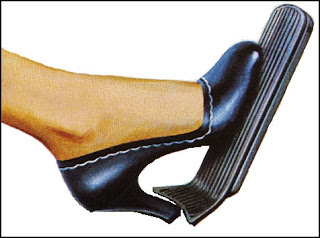People often say they have trouble tapping their feet while they play. But they’ve got it all wrong; they just need to step on the gas. Let me explain.
It’s really helpful musically, emotionally, and physically to move to the beat while you play. Musically — by tapping, marching or moving in some other way, you are driving the beat, which is what music is all about. These motions are like a physical backup system that can take you through a tune and keep you on track. Emotionally — moving to the beat takes the edge off any tensions you may have and gives you a place to put them that’s part and parcel with your music making. Physically — moving as you play relieves your muscles of being frozen in one position, where they can get overstressed and cause strains and pains.
If you don’t move as you play, all your playing has to be managed in your head, which is of less help to you than you may imagine. Your mind can easily be overloaded with worries, demands, and so-called executive functions (the existence of which many neurologists have doubts about anyway). In addition, without teaming up with some sort of physical engagement, your mind can easily become overstimulated by complex sound, social cues, and bodily tensions. In another post, we’ll examine why, contrary to popular notions, playing music doesn’t start in your head. It starts with the ears, uses muscle memory, and engages the brain last.
But how to manage that pesky notion of “tapping your feet”? It doesn’t have to be the feet, by the way; if you feel the pulse of the tune strongly enough, you will move whatever is most natural to you. Notice what part of you moves when you are intently listening to any music with a strong beat. Use that motion, whether it’s tapping your feet, lifting heel, or other motion. It should be something natural to you. Tapping your feet should never be a task added to your mental list (yet another thing to unnecessarily overload the mind). Many people do think they’re supposed to tap feet and add it to their to-do list, imagining they can coordinate that on top of playing, which is why some find it difficult, and shy away from it.
And yet, tapping the foot to music is totally natural to everyone.
If you aren’t sure about this for yourself, just think about how you use the accelerator in your car. Is that on some sort of to-do list in addition to remembering to steer, control wipers, turn signals, shifting? Or is it totally natural for you to step on the gas when you want to move the car? If you don’t drive, think about how you push the pedal of a bike when you want to move forward.
You naturally move that foot on the gas pedal every time you want the car to move. Try feeling that motion when you play fiddle! It’s a great compliment to dance fiddlers when people say that they can really drive the tunes.
If you step, step, step on the gas while driving (please don’t try this with a carsick-prone passenger!), your car will jerk forward, forward, forward. “Stepping on the gas” while you play will move your tune on the beat, beat, beat.
That’s priority #1. Know the notes that fit on those beats, and the bow direction of each. I recommend a simple formula that can be easy physically rather than challenging mentally. For example, downbow on every beat in a reel, or in a jig, downbow on beat one and upbow on beat two. Organize your bowing to make this happen consistently. Then when you step on the gas, your bow can match with those beat notes effortlessly. Fitting in the nonbeat notes is way easier when they just squeeze in between the beat notes, rather than lining them up individually in an endless sequence that an overly ambitious brain believes it can memorize! It can’t. But the ears know what’s happening, and your muscle memory can match your bow to the beat notes. It all comes down to driving that beat.
Just remember, if you want that tune to move forward, step on the gas!



